CS6503 TOC Question Bank PDF
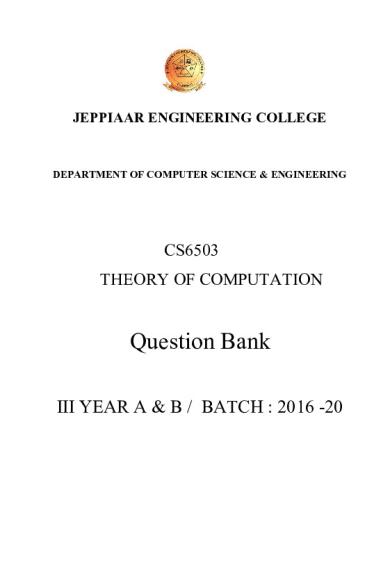
| Title | CS6503 TOC Question Bank |
|---|---|
| Course | Theory of computation |
| Institution | Anna University |
| Pages | 38 |
| File Size | 1.5 MB |
| File Type | |
| Total Downloads | 85 |
| Total Views | 155 |
Summary
question bank...
Description
JEPPIAAR ENGINEERING COLLEGE
DEPARTMENT OF COMPUTER SCIENCE & ENGINEERING
CS6503 THEORY OF COMPUTATION
Question Bank III YEAR A & B / BATCH : 2016 -20
Vision of Institution To build Jeppiaar Engineering College as an Institution of Academic Excellence in Technical education and Management education and to become a World Class University. Mission of Institution M1
To excel in teaching and learning, research and innovation by promoting the principles of scientific analysis and creative thinking
M2
To participate in the production, development and dissemination of knowledge and interact with national and international communities
M3
To equip students with values, ethics and life skills needed to enrich their lives and enable them to meaningfully contribute to the progress of society
M4
To prepare students for higher studies and lifelong learning, enrich them with the practical and entrepreneurial skills necessary to excel as future professionals and contribute to Nation’s economy
Program Outcomes (POs) PO1 PO2
PO3
PO4 PO5 PO6 PO7 PO8
Engineering knowledge: Apply the knowledge of mathematics, science, engineering fundamentals, and an engineering specialization to the solution of complex engineering problems. Problem analysis: Identify, formulate, review research literature, and analyze complex engineering problems reaching substantiated conclusions using first principles of mathematics, natural sciences, and engineering sciences. Design/development of solutions: Design solutions for complex engineering problems and design system components or processes that meet the specified needs with appropriate consideration for the public health and safety, and the cultural, societal, and environmental considerations Conduct investigations of complex problems: Use research-based knowledge and research methods including design of experiments, analysis and interpretation of data, and synthesis of the information to provide valid conclusions. Modern tool usage: Create, select, and apply appropriate techniques, resources, and modern engineering and IT tools including prediction and modeling to complex engineering activities with an understanding of the limitations. The engineer and society: Apply reasoning informed by the contextual knowledge to assess societal, health, safety, legal and cultural issues and the consequent responsibilities relevant to the professional engineering practice. Environment and sustainability: Understand the impact of the professional engineering solutions in societal and environmental contexts, and demonstrate the knowledge of, and need for sustainable development. Ethics: Apply ethical principles and commit to professional ethics and responsibilities and norms of the engineering practice.
PO9
PO10
PO11 PO12
Individual and team work: Function effectively as an individual, and as a member or leader in diverse teams, and in multidisciplinary settings. Communication: Communicate effectively on complex engineering activities with the engineering community and with society at large, such as, being able to comprehend and write effective reports and design documentation, make effective presentations, and give and receive clear instructions. Project management and finance: Demonstrate knowledge and understanding of the engineering and management principles and apply these to one’s own work, as a member and leader in a team, to manage projects and in multidisciplinary environments. Life-long learning: Recognize the need for, and have the preparation and ability to engage in independent and life-long learning in the broadest context of technological change.
Vision of Department To emerge as a globally prominent department, developing ethical computer professionals, innovators and entrepreneurs with academic excellence through quality education and research. Mission of Department M1
To create computer professionals with an ability to identify and formulate the engineering problems and also to provide innovative solutions through effective teaching learning process.
M2
To strengthen the core-competence in computer science and engineering and to create an ability to interact effectively with industries.
M3
To produce engineers with good professional skills, ethical values and life skills for the betterment of the society.
M4
To encourage students towards continuous and higher level learning on technological advancements and provide a platform for employment and self-employment.
Program Educational Objectives (PEOs) PEO1
To address the real time complex engineering problems using innovative approach with strong core computing skills.
PEO2
To apply core-analytical knowledge and appropriate techniques and solutions to real time challenges of national and global society
PEO3
Apply ethical knowledge for professional excellence and leadership for the betterment of the society.
PEO4
Develop life-long entrepreneurship
learning
skills
needed
for
better
provide
employment
and
Program Specific Outcomes (PSOs) Students will be able to
An ability to understand the core concepts of computer science and engineering and to PSO1 enrich problem solving skills to analyze, design and implement software and hardware based systems of varying complexity. To interpret real-time problems with analytical skills and to arrive at cost effective and PSO2 optimal solution using advanced tools and techniques. An understanding of social awareness and professional ethics with practical proficiency in the broad area of programming concepts by lifelong learning to inculcate employment and PSO3 entrepreneurship skills.
BLOOM TAXANOMY LEVELS(BTL) BTL6: Creating., BTL 5: Evaluating., BTL 4: Analyzing., BTL 3: Applying., BTL 2: Understanding., BTL 1: Remembering
SYLLABUS
THEORY OF COMPUTATION – CS6503 (V SEMESTER) UNIT I
FINITE AUTOMATA
Introduction- Basic Mathematical Notation and techniques- Finite State systems – Basic Definitions –Finite Automaton – DFA & NDFA – Finite Automaton with €- moves – Regular Languages- Regular Expression – Equivalence of NFA and DFA – Equivalence of NDFA’s with and without €-moves –Equivalence of finite Automaton and regular expressions –Minimization of DFA- - Pumping Lemma for Regular sets – Problems based on Pumping Lemma. UNIT II
GRAMMARS
Grammar Introduction– Types of Grammar - Context Free Grammars and Languages– Derivations and Languages – Ambiguity- Relationship between derivation and derivation trees – Simplification of CFG – Elimination of Useless symbols - Unit productions - Null productions – Greiback Normal form – Chomsky normal form – Problems related to CNF and GNF. UNIT III
PUSHDOWN AUTOMATA
Pushdown Automata- Definitions – Moves – Instantaneous descriptions – Deterministic pushdown automata – Equivalence of Pushdown automata and CFL - pumping lemma for CFL – problems based on pumping Lemma. UNIT IV
TURING MACHINES
Definitions of Turing machines – Models – Computable languages and functions –Techniques for Turing machine construction – Multi head and Multi tape Turing Machines - The Halting problem –Partial Solvability – Problems about Turing machine- Chomskian hierarchy of languages. UNIT V
UNSOLVABLE PROBLEMS AND COMPUTABLE FUNCTIONS
Unsolvable Problems and Computable Functions – Primitive recursive functions – Recursive and recursively enumerable languages – Universal Turing machine. MEASURING AND CLASSIFYING COMPLEXITY: Tractable and Intractable problems- Tractable and possibly intractable problems - P and NP completeness - Polynomial time reductions.
Total= 45 Periods
TEXT BOOKS: 1.
Hopcroft J.E., Motwani R. and Ullman J.D, “Introduction to Automata Theory, Languages and Computations”, Second Edition, Pearson Education, 2008. (UNIT 1,2,3)
2.
John C Martin, “Introduction to Languages and the Theory of Computation”, Third Edition, Tata McGraw Hill Publishing Company, New Delhi, 2007. (UNIT 4,5)
REFERENCES: 1. Mishra K L P and Chandrasekaran N, “Theory of Computer Science Automata, Languages and Computation”, Third Edition, Prentice Hall of India, 2004. 2. Harry R Lewis and Christos H Papadimitriou, “Elements of the Theory of Computation”, Second Edition, Prentice Hall of India, Pearson Education, New Delhi, 2003. 3. Peter Linz, “An Introduction to Formal Language and Automata”, Third Edition, Narosa Publishers, New Delhi, 2002.
4. Kamala Krithivasan and Rama. R, “Introduction to Formal Languages, Automata Theory and Computation”, Pearson Education 2009 NOTE :REFER NOTES FOR PART B PROBLEMS
Course Outcomes (COs) C504.1
Design Finite State Automata and Regular Expression for any language
C504.2
Illustrate the design of Context Free Grammar for any language set
C504.3
Demonstrate the push down automaton model for the given language
C504.4
Make use of Turing machine concept to solve the simple problems
C504.5
Explain decidability or undesirability of various problems
INDEX Unit #
Ref. Book Hopcroft J.E., Motwani R. and Ullman J.D, “Introduction to Automata
Unit 1
Theory, Languages and Computations”, Second Edition, Pearson Education, 2008. (UNIT 1,2,3) Mishra K L P and Chandrasekaran N, “Theory of Computer Science Automata, Languages and Computation”, Third Edition, Prentice Hall of India, 2004. Hopcroft J.E., Motwani R. and Ullman J.D, “Introduction to Automata
Unit 2
Theory, Languages and Computations”, Second Edition, Pearson Education, 2008. (UNIT 1,2,3) Mishra K L P and Chandrasekaran N, “Theory of Computer Science Automata, Languages and Computation”, Third Edition, Prentice Hall of India, 2004. Hopcroft J.E., Motwani R. and Ullman J.D, “Introduction to Automata
Unit 3
Theory, Languages and Computations”, Second Edition, Pearson Education, 2008. (UNIT 1,2,3) Mishra K L P and Chandrasekaran N, “Theory of Computer Science Automata, Languages and Computation”, Third Edition, Prentice Hall of India, 2004. John C Martin, “Introduction to Languages and the Theory of
Unit 4
Computation”, Third Edition, Tata McGraw Hill Publishing Company, New Delhi, 2007. (UNIT 4,5)
John C Martin, “Introduction to Languages and the Theory of
Unit 5
Computation”, Third Edition, Tata McGraw Hill Publishing Company, New Delhi, 2007. (UNIT 4,5)
UNIT I
FINITE AUTOMATA
Introduction- Basic Mathematical Notation and techniques- Finite State systems – Basic Definitions –Finite Automaton – DFA & NDFA – Finite Automaton with €- moves – Regular Languages- Regular Expression – Equivalence of NFA and DFA – Equivalence of NDFA’s with and without €-moves –Equivalence of finite Automaton and regular expressions –Minimization of DFA- - Pumping Lemma for Regular sets – Problems based on Pumping Lemma.
S. No.
Question
Course Outcome
Blooms Taxanomy Level
Define (a)
Finite Automata (FA)
(b)
Transition Diagram NOV/DEC 2012
C504.1
BTL 1
C504.1
BTL 1
Finite Automata is a 5 tuples denoted by A = (Q, ∑, δ, q0, F) where 1
2
•
Q is a finite set of states
•
∑ is the finite set of input symbols
•
δ is a transition function (Q X ∑ → Q )
•
q0 is the start state or initial state
•
F is a set of final or accepting states
State the Principle of induction. NOV/DEC 2012 Refer notes
3
What is proof by contradiction?
MAY/JUNE 2012 Refer notes
4
C504.1
BTL 1
C504.1
BTL 1
C504.1
BTL 1
C504.1
BTL 1
Define ε-closure(q) with an example. MAY/JUNE 2012 Refer notes Differentiate between proof by contradiction and proof by contrapositive. APR/MAY 2011
5
If H then C will be proved by assuming ~H and then proving falsehood of falsehood of C. This is proof by contadiction. Proof by contrapositive is proved by assuming ~H and proving ~C. Construct a DFA for the language over {0, 1}* such that it contains “000” as a substring. APR/MAY 2011 1
6
0,1
Q0
Q1
0
Q2
Q3
0
0 1 What is structural induction? NOV/DEC 2011 C504.1
BTL 1
C504.1
BTL 1
Let S(X) be a statement about the structures X that are defined by some particular recursive definition. 7
1. As a basis, Prove S(X) for the basis structure(s) X. 2. For inductive step, take a structure X that the
recursive definition says is formed from Y1, Y2,....Yk. Assume the statements S(Y1),...,S(Yk) and use these to prove S(X).
8
State the difference between NFA and DFA. NOV/DEC 2011 DFA must emit one and only one vertex/line/edge for each element of the alphabet. NFA do not have to
obey this and can have multiple edges labeled with the same letter (repetition) and /or edges labeled with the empty string. Both DFA and NFA recognize the same languages – the regular languages. 1. Construct deterministic finite automata to recognize odd number of 1’s and even number of 0’s?
C504.1
BTL 1
C504.1
BTL 1
C504.1
BTL 1
C504.1
BTL 1
APR/MAY 2010 1
9
0
0 C
B
1
A
0 1
0 D
1
10
State the relations among regular expression, deterministic finite automata, non deterministic finite automaton and finite automaton with epsilon transition. APR/MAY 2010 Every Regular language defined by a regular expression ia also defined by the finite automata. If a Regular language ‘L’ is accepted by a NFA then there exists a DFA that accepts ‘L’. What is inductive proof? NOV/DEC 2010 Statement P(n) follows from
11
(a)
P(0) and
(b)
P(n-1) implies P(n) for n>=1
Condition (a) is an inductive proof is the basis and Condition (b) is called the inductive step. 12
Find the set of strings accepted by the finite automata. NOV/DEC 2010
0, 1
(0+1)* or L={ε, 0, 1, 00, 01, 10, 11,............} What is MAY/JUNE 2013 13
meant
by
DFA
Define the term Epsilon transition MAY/JUNE 2013 14
C504.1
BTL 1
C504.1
BTL 1
C504.1
BTL 1
C504.1
BTL 1
C504.1
BTL 1
DFA—also known as deterministic finite state machine—is a finite state machine that accepts/rejects finite strings of symbols and only produces a unique computation (or run) of the automaton for each input string.
In the automata theory, a nondeterministic finite automaton with ε-moves (NFA-ε)(also known as NFA-λ) is an extension of nondeterministic finite automaton(NFA), which allows a transformation to a new state without consuming any input symbols
Draw the transition diagram for an identifier NOV/DEC 2013 15
letter
letter,digit
What is non deterministic finite automata? NOV/DEC 2013 16
In automata theory, a nondeterministic finite automaton (NFA), or nondeterministic finite state machine, is a finite state machine that (1) does not require input symbols for state transitions and (2) is capable of transitioning to zero or two or more states for a given start state and input symbol Define Deductive Proof.
17
NOV/DEC 2014 A Deductive proof consists of a sequence of statements whose truth leads us from some initial
statement, called the ‘hypothesis’ to a ‘conclusion’ statement. “if H then C” Ex: if x >= 4 then 2x >= x2 1. Design DFA to accept strings over ∑ = (0,1) with two consecutive 0’s.NOV/DEC 2014 C504.1
BTL 1
1 0,1 q0
18
q3
q1
0
0
1 What is a finite automaton? NOV/DEC 2015 A finite automaton (FA) is a simple idealized machine used to recognize patterns within input taken from some character set (or alphabet) C. The job of an FA is to accept or reject an input depending on whether the pattern defined by the FA occurs in the input. Finite Automata is a 5 tuples denoted by 19
A = (Q, ∑, δ, q0, F) where •
Q is a finite set of states
•
∑ is the finite set of input symbols
•
δ is a transition function (Q X ∑ → Q )
•
q0 is the start state or initial state
•
F is a set of final or accepting states
C504.1
BTL 1
20
Write Regular Expression for the set of strings over {0.1} that have atleast one. NOV/DEC 2015
C504.1
BTL 1
C504.1
BTL 1
C504.1
BTL 1
C504.1
BTL 1
C504.1
BTL 1
C504.1
BTL 1
C504.1
BTL 1
C504.1
BTL 1
Regualr Expression = (0+1)*1
21
22
Draw a Non-deterministic finite automata to accept strings containing the substring 0101. MAY/JUNE 2016 Refer Notes State the pumping lemma for regular languages. MAY/JUNE 2016Refer Notes Define the languages described by DFA and NFA.
23
L(DFA) = { w / δ‟(q0,w) is in F}.It is the set of strings w that take the start state q0 to one of the accepting states. L(NFA)= { w / δ‟(q0,w)∩F≠ }.It is the set of strings w such that δ‟(q0,w)contains at least one accepting state. Define extended transition function for a DFA. The extended transition function δ‟: Qε∑ * εQ is defined as follows.
24
(i) δ’(q, ε ) = q (ε - Empty) (ii)Suppose w is a string of form xa(w= xa), wε∑*and q Q , then δ’(q, w)= δ( δ’(q, x),a)
25
Give a regular expression for the set of all strings having odd number of 1’s RE= 1(0+11)*
26
Give the regular expression for the set of all strings ending in 00. Regular expression = (0+1)*00 When two states are equivalent and distinguishable?
27
We say that two states p and q are equivalent iff for each input string x , δ(p,x) is an accepting state iff
δ(q,x) is an accepting state. p is distinguishable from q if there exists an x such that δ(p,x) is in F and v is not in F or vice versa. What are the applications of regular expression? 28
Regular expression in UNIX, Lexical analysis, Pattern searching
C504.1
BTL 1
C504.1
BTL 1
C504.1
BTL 1
C504.1
BTL 1
C504.1
BTL 1
C504.1
BTL 1
C504.1
BTL 1
Write regular expressions fo...
Similar Free PDFs

CS6503 TOC Question Bank
- 38 Pages

Dmdw-question bank - question bank
- 17 Pages

Question bank
- 8 Pages

Toc 2 marks - 2 mark question answer
- 31 Pages
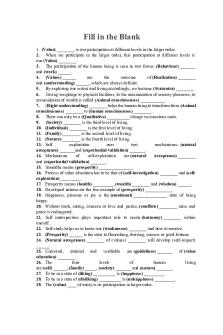
Question Bank 3question bank
- 6 Pages

Question BANK
- 19 Pages
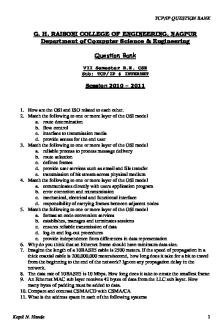
Tcp-ip-question-bank
- 25 Pages

Chapter 4 - Question Bank
- 28 Pages

DIP Question Bank Sheetal
- 14 Pages
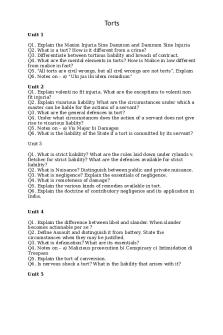
Torts Question Bank
- 2 Pages
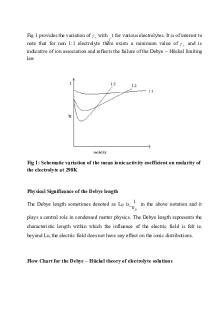
QB5 - Question Bank 5
- 104 Pages

Assessment Question Bank 1
- 22 Pages
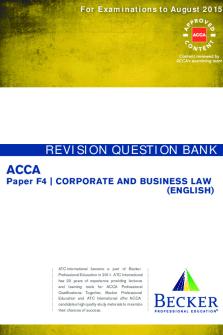
Revision Question Bank 60
- 154 Pages
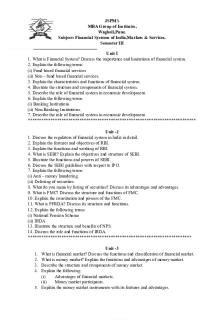
Fsims Question Bank
- 4 Pages

11. Autocad question bank
- 14 Pages
Popular Institutions
- Tinajero National High School - Annex
- Politeknik Caltex Riau
- Yokohama City University
- SGT University
- University of Al-Qadisiyah
- Divine Word College of Vigan
- Techniek College Rotterdam
- Universidade de Santiago
- Universiti Teknologi MARA Cawangan Johor Kampus Pasir Gudang
- Poltekkes Kemenkes Yogyakarta
- Baguio City National High School
- Colegio san marcos
- preparatoria uno
- Centro de Bachillerato Tecnológico Industrial y de Servicios No. 107
- Dalian Maritime University
- Quang Trung Secondary School
- Colegio Tecnológico en Informática
- Corporación Regional de Educación Superior
- Grupo CEDVA
- Dar Al Uloom University
- Centro de Estudios Preuniversitarios de la Universidad Nacional de Ingeniería
- 上智大学
- Aakash International School, Nuna Majara
- San Felipe Neri Catholic School
- Kang Chiao International School - New Taipei City
- Misamis Occidental National High School
- Institución Educativa Escuela Normal Juan Ladrilleros
- Kolehiyo ng Pantukan
- Batanes State College
- Instituto Continental
- Sekolah Menengah Kejuruan Kesehatan Kaltara (Tarakan)
- Colegio de La Inmaculada Concepcion - Cebu
